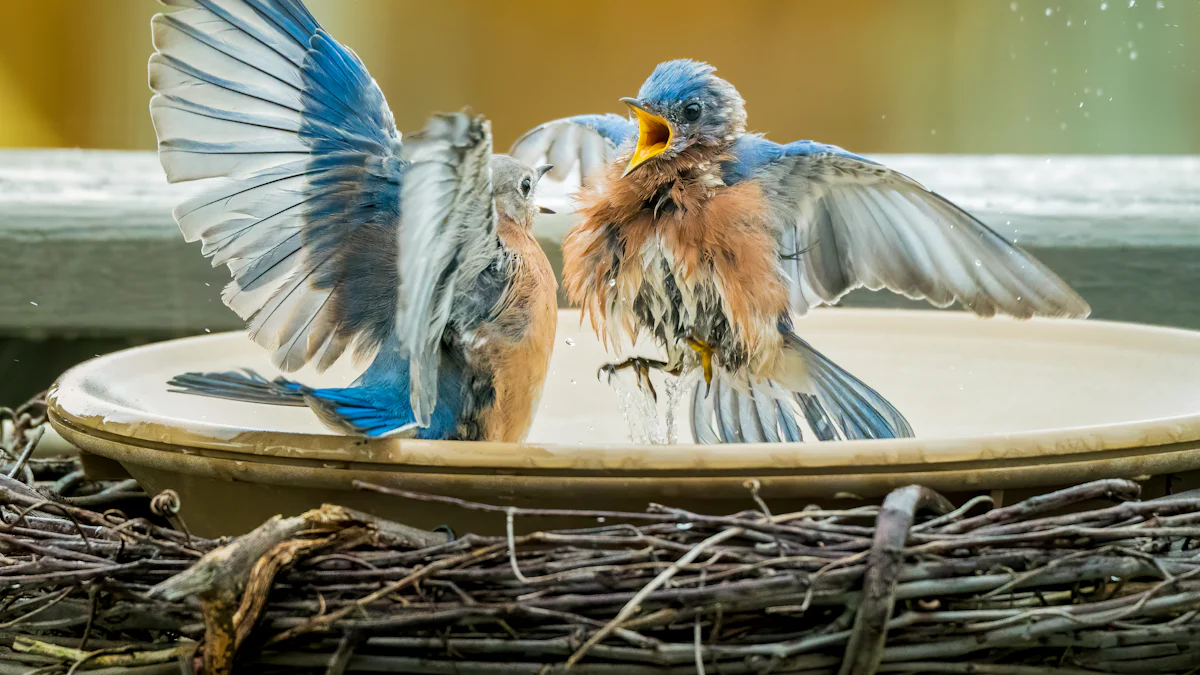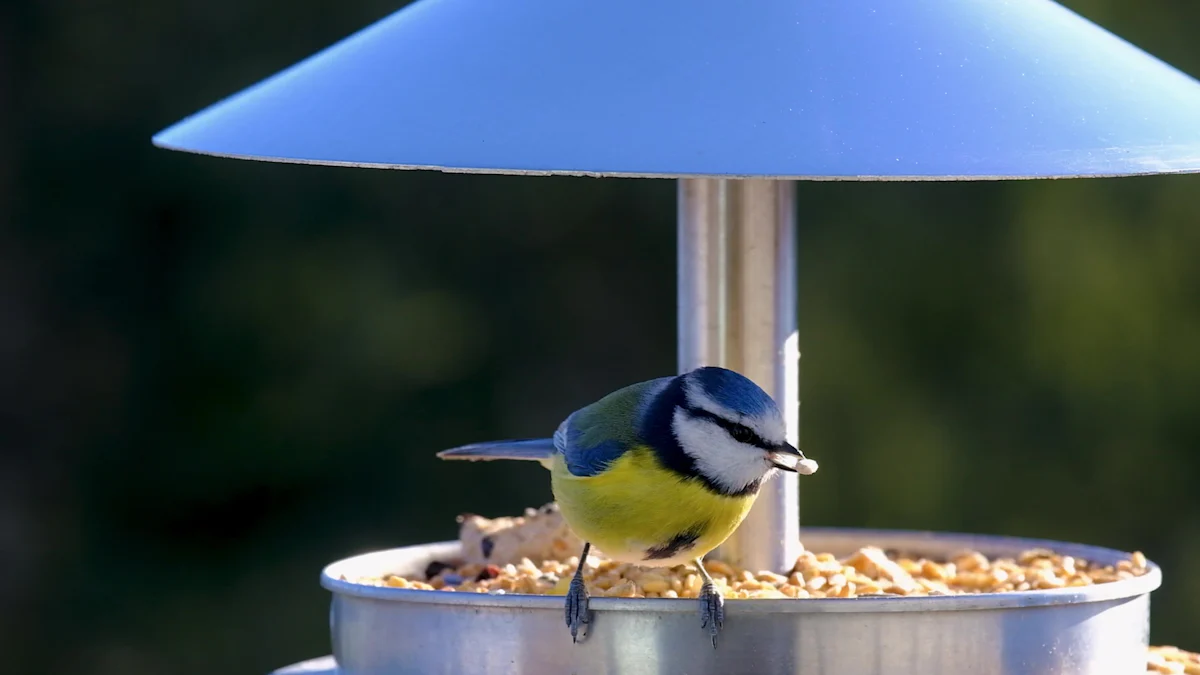
Mealworms are like a gourmet treat for birds. They’re packed with protein and can bring a variety of feathered friends to your yard. If you’ve ever wondered how to offer them, it’s easier than you think. You can use a mealworm feeder for birds or simply place them on a flat surface. Either way, birds will love it! Watching them enjoy this nutritious snack is not only rewarding but also helps support their health and energy.
Key Takeaways
- Mealworms are healthy snacks for birds, full of protein. Feeding them can bring many bird types to your yard.
- Live mealworms give water and attract birds that eat bugs. Dried mealworms are easy to store and last a long time.
- Use a special feeder to hold mealworms in one place. This keeps pests away and makes feeding simple.
- Change how often you feed based on bird visits. Give mealworms once or twice daily, especially in the morning when birds are busy.
- Try raising your own mealworms to save money and have fresh ones. Use a small box with bedding to start.
Types of Mealworms

Live Mealworms
Benefícios de uvas vivas
Live mealworms are a favorite for many birds. They wiggle and move, which grabs a bird’s attention instantly. This movement mimics the natural prey birds hunt in the wild. Live mealworms are also packed with moisture, making them an excellent hydration source, especially during hot weather. Birds like bluebirds, robins, and wrens absolutely love them. If you want to attract insect-eating birds, live mealworms are the way to go.
Tip: Offering live mealworms can help you attract new bird species to your yard.
How to handle and store live mealworms
Handling live mealworms might seem tricky, but it’s easier than you think. Use a small scoop or tweezers to pick them up if you’re squeamish. To store them, keep them in a container with small air holes. Place the container in a cool spot, like your refrigerator, to slow their growth. Add a bit of oatmeal or bran as bedding and a slice of carrot or potato for food. This keeps them fresh and healthy for your feathered visitors.
Dried Mealworms
Benefícios das toranjas secas
Dried mealworms are super convenient. They don’t wriggle, so they’re easier to handle. They also have a long shelf life, making them perfect for occasional feeding. While they lack the moisture of live mealworms, they still provide plenty of protein. Birds like chickadees, woodpeckers, and sparrows enjoy them just as much.
How to rehydrate dried mealworms
Rehydrating dried mealworms is simple. Soak them in warm water for about 10-15 minutes. This softens them and adds moisture, making them more appealing to birds. Once rehydrated, they’re ready to serve. You can even mix them with seeds for a tasty bird buffet.
Choosing the Right Type
Factors to consider
When choosing between live and dried mealworms, think about your needs and the birds you want to attract. Live mealworms are great for hydration and attracting insect-eating birds. Dried mealworms are better for convenience and long-term storage.
Recommendations for different bird species
For bluebirds, robins, and wrens, live mealworms work best. If you’re feeding chickadees, sparrows, or woodpeckers, dried mealworms are a fantastic option. Experiment with both types to see what works for your backyard visitors.
Note: Offering a mix of live and dried mealworms can attract a wider variety of birds.
How to Serve Mealworms

Feeding Methods
Using a mealworm feeder for birds
Using a mealworm feeder for birds is one of the easiest ways to serve this tasty treat. These feeders are designed to keep mealworms contained while making them accessible to birds. You can hang them in your yard or garden, preferably in a spot where birds feel safe. Look for feeders with small openings or mesh designs to prevent mealworms from falling out. This method also keeps the mealworms off the ground, reducing the chance of attracting unwanted pests like ants or rodents.
Tip: Place the feeder near shrubs or trees. Birds feel more comfortable feeding when they have a quick escape route.
Placing mealworms on trays or flat surfaces
If you don’t have a mealworm feeder for birds, a simple tray or flat surface works just as well. Spread the mealworms out so birds can easily spot them. This method is great for ground-feeding birds like robins or blackbirds. Just make sure the surface is clean and placed in a visible area. You can even use a shallow dish or an old plate for this purpose.
Note: Avoid placing mealworms directly on the ground. This can attract predators or pests.
Best Mealworm Feeders
Features of a good mealworm feeder
A good mealworm feeder for birds should be sturdy, easy to clean, and weather-resistant. Look for feeders with a design that prevents mealworms from escaping. A roof or cover is a bonus, as it protects the mealworms from rain. The feeder should also allow birds to perch comfortably while they eat.
Examples of effective feeders
Some popular options include mesh feeders, dish-style feeders, and platform feeders with raised edges. Mesh feeders work well for live mealworms, while dish-style feeders are perfect for dried ones. You can find these at most garden centers or online stores. Experiment with different types to see which one your backyard birds prefer.
Frequência de alimentação
How often to feed mealworms
You don’t need to offer mealworms all day. Once or twice a day is enough to keep birds happy. Morning is the best time, as birds are most active then. If you’re using a mealworm feeder for birds, check it regularly to ensure it’s not empty.
Adjusting based on bird activity
Pay attention to how quickly the mealworms disappear. If they’re gone within minutes, you might want to add more. On the other hand, if mealworms are left untouched, reduce the amount. Adjusting the feeding frequency helps you avoid waste and keeps the birds coming back.
Practical Tips for Feeding Mealworms
Storing Mealworms
Proper storage for live mealworms
Keeping live mealworms fresh is simple if you store them correctly. Place them in a breathable container with small air holes. Add a layer of oatmeal or bran as bedding, and toss in a slice of carrot or potato for food. Store the container in your refrigerator. The cool temperature slows their growth and keeps them alive longer. Check on them every few days to replace the food and bedding. This ensures they stay healthy and ready for your feathered visitors.
Keeping dried mealworms fresh
Dried mealworms are much easier to store. Keep them in an airtight container to prevent moisture from getting in. Store the container in a cool, dry place, away from direct sunlight. If you buy them in bulk, divide them into smaller portions to avoid exposing the entire batch to air every time you open the container. Proper storage keeps them fresh and appealing to birds.
Budget-Friendly Feeding
Buying mealworms in bulk
Buying mealworms in bulk can save you money in the long run. Many online retailers and pet stores offer discounts for larger quantities. Bulk purchases are especially useful if you feed birds regularly. Just make sure you have enough storage space to keep them fresh, whether they’re live or dried.
Growing your own mealworms
If you’re looking for an even more cost-effective option, consider growing your own mealworms. It’s easier than you might think! Start with a small container, some oatmeal or bran, and a few live mealworms. Over time, they’ll reproduce, giving you a steady supply. This method not only saves money but also ensures you always have fresh mealworms on hand.
Training Birds to Eat Mealworms
Introducing mealworms to birds
If birds in your yard aren’t familiar with mealworms, start small. Scatter a few mealworms on a tray or flat surface where birds already feed. You can also mix them with seeds to make the transition easier. Once birds recognize mealworms as food, they’ll come back for more.
Encouraging shy birds to try mealworms
Some birds might be hesitant at first. To encourage them, place mealworms near shrubs or trees where they feel safe. You can also use a mealworm feeder for birds to make the food more accessible. Patience is key. Over time, even the shyest birds will warm up to this tasty treat.
Seasonal Considerations
Spring Feeding
Supporting nesting birds
Spring is a busy time for birds. They’re building nests, laying eggs, and raising chicks. Mealworms can give them the extra energy they need during this demanding season. You can help by offering mealworms daily. Birds like robins and bluebirds will especially appreciate this protein boost. Place the mealworms in a feeder or on a tray near nesting areas. This makes it easier for parent birds to grab food and return to their nests quickly.
Tip: If you notice birds carrying mealworms away, they’re likely feeding their chicks. Keep the supply steady to support their growing families.
Summer Feeding
Providing energy during molting
Summer is molting season for many birds. They shed old feathers and grow new ones, which takes a lot of energy. Mealworms are an excellent source of protein to help them through this process. You might see birds looking a little scruffy during this time. Don’t worry—it’s normal! Offer mealworms in the morning when birds are most active. You can also mix them with seeds to create a balanced meal.
Note: Keep feeders clean during summer. Warm weather can attract pests or cause food to spoil faster.
Fall and Winter Feeding
Helping birds prepare for migration or survive the cold
Fall is all about preparation. Many birds are getting ready to migrate, while others are storing energy for the colder months. Mealworms can provide the fuel they need. In winter, food becomes scarce. Offering mealworms can make a big difference for birds trying to survive freezing temperatures. Place feeders in sheltered spots to protect the food from snow or wind.
Reminder: Increase the amount of mealworms during harsh weather. Birds burn more calories staying warm and will rely on your help.
Feeding mealworms to birds is a fun and easy way to support their health while bringing more life to your yard. By picking the right type of mealworms and using a mealworm feeder for birds, you’ll make sure they get the most out of this protein-packed treat. Don’t forget to adjust your feeding based on the seasons to meet their needs. Start today, and you’ll love watching your feathered friends thrive and return for more!
FAQ
What types of birds eat mealworms?
Many birds love mealworms! Bluebirds, robins, wrens, chickadees, and woodpeckers are just a few examples. Even some ground-feeding birds like blackbirds enjoy them. Offering mealworms can attract a variety of species to your yard.
Posso alimentar as larvas a pássaros durante todo o ano?
Yes, you can! Mealworms are beneficial in every season. They help nesting birds in spring, support molting in summer, and provide energy during fall migration or winter cold. Adjust the amount based on bird activity and weather.
Are live or dried mealworms better?
It depends on your needs. Live mealworms are great for hydration and attracting insect-eating birds. Dried mealworms are convenient and last longer. Mixing both types can appeal to a wider range of birds.
How do I keep mealworms from attracting pests?
Use a mealworm feeder to keep them off the ground. Clean the feeder regularly and avoid overfeeding. Placing the feeder in a sheltered spot also helps reduce the chance of attracting ants or rodents.
Can I grow my own mealworms?
Absolutely! Start with a container, some oatmeal or bran, and a few live mealworms. They’ll reproduce over time, giving you a steady supply. It’s a budget-friendly way to keep your birds happy.


